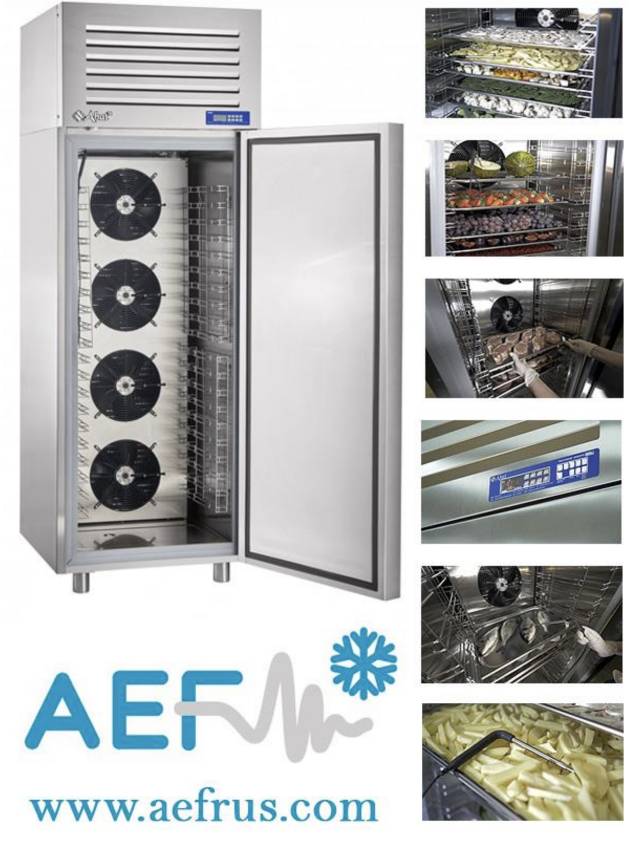AEF - Acoustic Extra Freezing Technology and Products
AEF technology is based on the technologies of crystal growth developed in different branches of industry. Multidisciplinary knowledge allowed AEF specialists to transfer this achievement to the food industry and apply it to the freezing of food products. AEF technology provides nano-crystallization of ice and, as a result, food products can be stored for a long time. Not only the cell walls are not damaged, but also the nuclei. There is no dehydration of proteins. The nutrient composition and taste of the product is fully preserved. The quality of products after AEF acoustic freezing is confirmed by numerous scientific studies.
AEF freezing technology leverages acoustic waves to form nano-sized ice crystals, keeping all food cells intact, resulting in: better taste, double shelf life, low drip loss, cost and energy savings.
-
Acoustic Extra Freezing (AEF) was one of ten startup teams participating in the EIT FAN Helsinki hub’s acceleration program in 2020.
-
The Sweden Foodtech Big Meet 2023 is an annual foodtech conference that brings together best foodtech companies, entrepreneurs, scientists and chefs from all over the world.
-
Acoustic Extra Freezing was a part of ‘FoodTech 500 Lab’ exhibition which was showcasing some of the most cutting-edge innovative companies.
AEF acoustic freezing allows you to double the capacity of your existing air blast freezer and preserve foods for a long time without loss of quality or flavour. It is possible to significantly increase shelf life of food products, to deliver both cooked food and ingredients to the other side of the world. You will get the maximum quality available on the market with minimum losses and no shelf life restrictions.
They took the crystallization process in the production of diamonds from molten carbon, microprocessor technologies and Soviet research in the field of cryobiology and crystallography as a guideline.
“Everyone sells freezing equipment.
Only we sell end results – quality and volume of frozen products”
– AEF Team
The introduction of AEF technology is a new direction in business and the ability to deliver your products to remote and hard-to-reach parts of our planet.
Before engaging in “sound” freezing, Dmitry Balabolin and his partner Igor Klimashevsky managed a network of metropolitan grocery stores. Then they opened the production of frozen cakes. And we were faced with the fact that there are no high—quality frozen berries on the market – they all turned out to be sour and sluggish.
The partners began to look for new freezing technologies that would preserve the color, taste and smell of berries. And in 2012-2013, they began to develop their own.
AEF Distribution
- USA
- South Korea
- New Zealand
- France
- Great Britain
- San Marino
- Finland
- Ukraine
- Indonesia
- Spain
- Holland
- Maldives
- Belgium
- Estonia
- Latvia
- Iceland
- Czech
- Vietnam
- Germany
- Bulgaria
- Sri Lanka
- Madagascar
- Armenia
- Norway
- Switzerland
- UAE
- Romania
The development began in Balabolin’s kitchen, which was filled with oscilloscopes, refrigerators, microscopes and test samples of products for freezing. Balabolin “unfrozen” all his knowledge gained at Moscow State University and MIREA, where he studied to be a chemist and an electronics physicist. At least 200 million rubles of their own funds were spent on home R&D and bringing the technology to the stage of mass production. This is only the cost of equipment and samples, without taking into account the cost of the team, since at the first stage we did everything ourselves.

How does the AEF technology differ from shock freezing, as well as from its improved version — individual IQF fast freezing? One of the important differences is the size of the ice crystals. The AEF installation creates acoustic waves that form microcrystals of ice in the product cells and in the space between them. They are a hundred times smaller in size than the cells themselves and do not damage them. Clusters of small crystals are formed, the fronts of which cannot be seen in a light microscope. At the same time, classical shock freezing at minus 40 degrees forms ice crystals that are comparable to the diameter of muscle fibers or larger, while a significant part of the crystals deforms and tears cell membranes.
It turns out that when using AEF technology, ice microcrystals are “grown” right inside the cell. The growth of ice crystals is regulated by acoustic vibrations, which are calculated separately for each type of product.
Some vibrations generate ice, others “grow” it, and others make distilled water form around the formed ice floes, which protects the cell from damage. At the same time, the freezing period is shortened — the smaller the ice particles, the faster it forms.
And the shelf life of the products increases: the crystals are arranged in such a way that they begin to “coalesce” (which, naturally, leads to the destruction of the product structure) no earlier than 15 months later at a storage temperature of minus 18 degrees. With the “shock” technology, the structure of the product is destroyed much faster, since it is already partially disrupted during the freezing process.
“All the pieces of ice are the same. In a microscope, they look like small peas in a jar, there are no large ones so that they can pierce the cell,” – Balabolin explains popularly. — Sound allows us to change the shape of crystals. Of course, people don’t hear him. There is a Japanese researcher who plays different music to the ice floes, and they change shape depending on whether Mozart sounds or Bach. We are doing something similar. It’s just that he acts like an artist, and we act like physicists.”
The AEF installation consists of acoustic devices that are built into the freezer, and an ice processor programmed to work with a particular type of product.
If desired, the AEF equipment can be integrated with the freezer equipment in operation at enterprises. After the product is frozen, it can be stored at minus 18 degrees.
Orders for the assembly of installations, the manufacture of circuit boards, radiators and other equipment are placed at several factories in Moscow.
The founders of the project are mainly engaged in engineering.
AEF technology has a famous analogue in the world — Japanese CAS systems (Cells Alive System, a system of living cells). This ABI corporation development uses magnetic vibrations that accelerate the growth of small crystals. The product freezes through almost instantly without damaging the cells.
The Japanese freeze, for example, bluefin tuna at minus 40 degrees for two years without loss of quality. But, according to Dmitry Balabolin, it is difficult for them to promote their product to the market because of its high cost. He and Klimashevsky themselves bought one installation from the Japanese for 60 million rubles to compare their technology with the Japanese.
Advantages of the technology:
-
The taste and texture of AEF products are equivalent to fresh products
-
Almost zero liquid loss during thawing of AEF products
-
Increased shelf life of frozen foods by 50-100%
-
Food can be prepared in the places of origin from local fresh products and, after FOIE freezing, transported over any distance and stored for a long time without loss in conventional freezers at a temperature of -18 °C and for a longer shelf life at -24 °C.
iVenturer's "DeepTalk" Podcast by Medialectica Episode 10: "Acoustic Extra Freezing: Food Preservation with Sound"
AEF installations are much cheaper: from five million rubles (the camera and the AEF system built into it) based on the productivity of two to five tons per day. If the company already has a refrigeration unit, then the installation of AEF will cost five million rubles. And if the customer agrees to lower productivity, then two million is enough.

